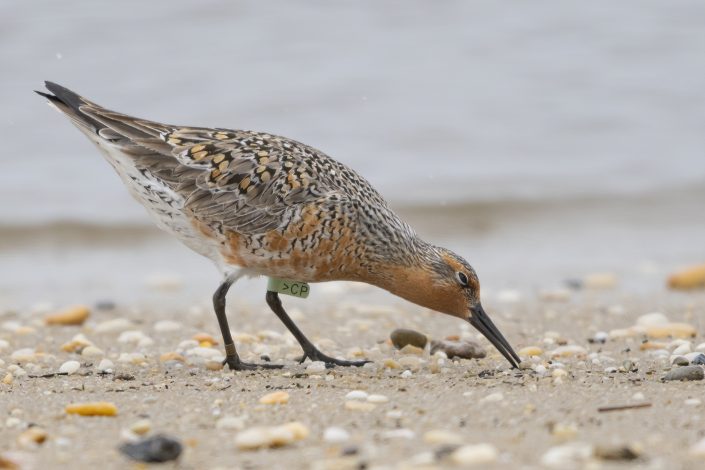RED KNOTS IN THE NEWS: Steep Decline in Red Knot Numbers this Spring
by Meghan Kolk, CWF Biologist

The number of red knots that visited the Delaware Bay this spring to rest and refuel on their long-distance migration from South America to the Arctic was the lowest recorded since counts began in 1982. The baywide counts, by Conserve Wildlife Foundation and our partners, which include the New Jersey and Delaware shorelines, resulted in only 6,880 red knots, roughly a third of what was counted last year, and less than a quarter of the population in the previous two years. In the early 1980s, when counts first began, almost 100,000 red knots migrated through the Delaware Bay. With recent numbers that were already below the level that would ensure survival, this latest decline makes the rufa red knot subspecies even more vulnerable and pushes it closer to extinction.
The extreme decline is thought to be caused by a poor breeding season in 2020. Last spring, unusually low water temperatures in the Bay delayed the horseshoe crab spawn until early June. When the red knots arrived in May, the horseshoe crab eggs were not available, and so they moved on with their migration without gaining the weight needed to finish the journey. The horseshoe crab eggs are an essential food source for these birds that need to double their weight before continuing their northbound journey. Without the eggs to refuel on, it is likely that 40 percent of the birds died before reaching the Arctic, diminishing the breeding population. Numbers of other migratory shorebirds that stop in the Delaware Bay, such as ruddy turnstones, sanderlings and semipalmated sandpipers also showed declines this year.
Another factor that may have contributed to the low numbers was adverse weather conditions in the Caribbean, making it more difficult for the birds to migrate north. The good news is that the horseshoe crab spawn was on time this year, and there were plenty of eggs available for the migrants that stopped to refuel. With such a long migration, there are so many factors that have to line up for a successful breeding season. We cannot control the weather conditions or the water temperatures, but one thing wildlife biologists want to ensure is that there are enough horseshoe crabs in the Bay to sustain the birds for the long term.
Further Reading:
- https://www.nytimes.com/2021/06/05/science/threatened-red-knot-shorebird-decline.html
- https://www.njspotlight.com/2021/05/red-knot-pushed-closer-extinction-delaware-bay-migration-stopover-shocking-decline-this-year-larry-niles-lowest-since-records-kept-1982/
Leave a Comment
Disturbing news re the Red Knot. It shows how fragile our environment is and the need to do all we can to nurture endangered species.
We visited Delaware Bay on Tuesday, May 25th looking for Red Knots. We found a few from Pierces Point Beach to Reeds Beach. More from Moore’s Beach to East Point Lighthouse. The most (a few hundred) were at Fortescue. That evening we went to Villas Beach and saw one banded Red Knot: +3E, which I reported. It was disappointing to see so very many Horsehoe Crabs and so few Red Knots.
We love the shorebirds and eagerly await their spring migration each year, are avid collectors of antique shorebird decoys used in the late 19th and early 20th century to hunt these delicate birds for market.
Thank God, market hunting was outlawed and shorebirds were protected.
We now need to protect Horseshoe Crabs from utilization from fisherman etc, and make sure that they will be available to migrating shorebirds for years to come.
Comments are closed.